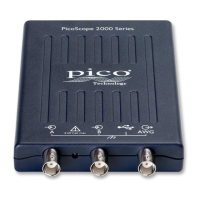PicoScope 2000 Series Programmer's Guide 35
Copyright © 2006–2016 Pico Technology Ltd. All rights reserved. ps2000pg.en r11
5.19
ps2000_run_streaming_ns
int16_t ps2000_run_streaming_ns
(
int16_t handle,
uint32_t sample_interval,
PS2000_TIME_UNITS time_units,
uint32_t max_samples,
int16_t auto_stop,
uint32_t noOfSamplesPerAggregate,
uint32_t overview_buffer_size
)
This function tells the oscilloscope to start collecting data in fast streaming mode. It
returns immediately without waiting for data to be captured. After calling it, you
should next call ps2000_get_streaming_last_values to copy the data to your
application's buffer.
PicoScope 2202, 2203, 2204, 2204A, 2205 and 2205A only
handle: the handle of the required oscilloscope
sample_interval: the time interval, in time_units, between
data points
time_units: the units in which sample_interval is measured
max_samples: the maximum number of samples that the driver
should store from each channel. Your computer must have enough
physical memory for this many samples, multiplied by the number
of channels in use, multiplied by the number of bytes per sample.
auto_stop: a Boolean to indicate whether streaming should stop
automatically when max_samples is reached. Set to any non-zero
value for TRUE.
noOfSamplesPerAggregate: the number of incoming samples
that the driver will merge together (or aggregate: see aggregation)
to create each value pair passed to the application. The value must
be between 1 and max_samples.
overview_buffer_size: the size of the overview buffers,
temporary buffers used by the driver to store data before passing it
to your application. You can check for overview buffer overruns
using the ps2000_overview_buffer_status function and adjust
the overview buffer size if necessary. The maximum allowable value
is 1,000,000. We recommend using an initial value of 15,000
samples.
non-zero: if streaming has been enabled correctly
0: if a problem occurred or a value was out of range

